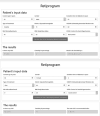Validation of a Diagnostic Support System for Diabetic Retinopathy Based on Clinical Parameters
- PMID: 34003951
- PMCID: PMC7980045
- DOI: 10.1167/tvst.10.3.17
Validation of a Diagnostic Support System for Diabetic Retinopathy Based on Clinical Parameters
Abstract
Purpose: To validate a clinical decision support system (CDSS) that estimates risk of diabetic retinopathy (DR) and to personalize screening protocols in type 2 diabetes mellitus (T2DM) patients.
Methods: We utilized a CDSS based on a fuzzy random forest, integrated by fuzzy decision trees with the following variables: current age, sex, arterial hypertension, diabetes duration and treatment, HbA1c, glomerular filtration rate, microalbuminuria, and body mass index. Validation was made using the electronic health records of a sample of 101,802 T2DM patients. Diagnosis was made by retinal photographs, according to EURODIAB guidelines and the International Diabetic Retinopathy Classification.
Results: The prevalence of DR was 19,759 patients (19.98%). Results yielded 16,593 (16.31%) true positives, 72,617 (71.33%) true negatives, 3165 (3.1%) false positives, and 9427 (9.26%) false negatives, with an accuracy of 0.876 (95% confidence interval [CI], 0.858-0.886), sensitivity of 84% (95% CI, 83.46-84.49), specificity of 88.5% (95% CI, 88.29-88.72), positive predictive value of 63.8% (95% CI, 63.18-64.35), negative predictive value of 95.8% (95% CI, 95.68-95.96), positive likelihood ratio of 7.30, and negative likelihood ratio of 0.18. The type 1 error was 0.115, and the type 2 error was 0.16.
Conclusions: We confirmed a good prediction rate for DR from a representative sample of T2DM in our population. Furthermore, the CDSS was able to offer an individualized screening protocol for each patient according to the calculated risk confidence value.
Translational relevance: Results from this study will help to establish a novel strategy for personalizing screening for DR according to patient risk factors.
Conflict of interest statement
Disclosure:
Figures
References
-
- Shaw JE, Sicree RA, Zimmet PZ.. Global estimates of the prevalence of diabetes for 2010 and 2030. Diabetes Res Clin Pract. 2010; 87(1): 4–14 - PubMed
-
- Wong TY, Sun J, Kawasaki R, et al. .. Guidelines on diabetic eye care: the International Council of Ophthalmology recommendations for screening, follow-up, referral, and treatment based on resource settings. Ophthalmology. 2018; 125(10): 1608–1622. - PubMed
-
- Gillibrand W, Broadbent D, Harding S, Vora J. The English national risk-reduction programme for preservation of sight in diabetes. Mol Cell Biochem. 2004; 261(1-2): 183–185. - PubMed
Publication types
MeSH terms
LinkOut - more resources
Full Text Sources
Other Literature Sources
Medical


